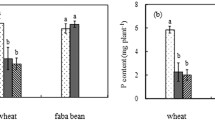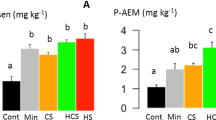Abstract
The main objective of the present study was to investigate phosphorus (P) dynamics in the rhizosphere of durum wheat (Triticum turgidum durum L.) and common bean (Phaseolus vulgaris L.) grown in monocropping and intercropping systems with nitrate supply. Wheat and common bean were grown either alone or in association in a cropping device with a thin (1 mm) soil layer sandwiched between large root mats. Wheat intercropped with common bean exhibited a 33% increase in shoot biomass and a 22% increased root biomass, without significantly affecting common bean growth. After 12 days of culture, rhizosphere pH decreased by 1.66 and 1.13 units in monocropping system of common bean and intercropping system, respectively. Wheat increased intercropped common bean proton release by 36% compared with monocropped beans. Common bean and wheat exhibited different behaviors in rhizosphere P dynamics. Monocropped wheat decreased Resin-P, NaHCO3-P and NaOH-P in its rhizosphere by 24, 96 and 10%, respectively. However, NaHCO3-P and NaOH-P were increased by 61 and 10% in the rhizosphere of intercropping. Almost all values about P fraction in intercropping system were between those in monocropped common bean and monocropped wheat. Through taping different P fraction, different plants species possibly can alleviate competition for phosphorus in intercropping system.




Similar content being viewed by others
References
Ae N, Arihara J, Okada K (1990) Phosphorus uptake by pigeon pea and its role in cropping systems of the Indian subcontinent. Science 248:477–480
AFNOR (1969) Dosage spectrophotométrique de l’anhydride phosphorique: méthode vanadomolybdique. AFNOR, Paris, pp 242–246
AFNOR (1994) Recueil de normes françaises. Qualité des sols, determination du pH. AFNOR, Paris, p 63
Barber SA (1984) Soil Nutrient Bioavailability: A mechanistic approach. Wiley, New York, p 398
Barrow NJ (1987) Reactions with variable charge soils. Martinus Nijhoff, Dordrecht
Bertrand I, Hinsinger P, Jaillard B, Arvieu JC (1999) Dynamics of phosphorus in the rhizosphere of maize and rape grown on synthetic, phosphated calcite and goethite. Plant Soil 211:111–119
Bieleski RL (1973) Phosphate pools, phosphate transport, and phosphate availability. Annu Rev Plant Physiol 24:225–252
Bowman RA, Cole CV (1978) Transformations of organic phosphorus substrates in soil as evaluated by NaHCO3 extractions. Soil Sci 125:49–54
Casarin V, Plassard C, Hinsinger P, Arvieu JC (2004) Quantification of ectomycorrhizal fungal effects on the bioavailability and mobilisation of soil P in the rhizosphere of Pinus pinaster. New Phytol 163:177–185
Cu STT, Hutson J, Schuller KA (2005) Mixed culture of wheat (Triticum aestivum L.) with white lupin (Lupinus albus L.) improves the growth and phosphorus nutrition of the wheat. Plant Soil 272:143–151
Dinkelaker B, Römheld V, Marschner H (1989) Citric acid excretion and precipitation of calcium in the rhizosphere of white lupin (Lupinus albus L.). Plant Cell Environ 12:285–292
Gahoonia TS, Nielsen NE, Joshi PA, Jahoor A (2001) A root hairless barley mutant for elucidating genetic of root hairs and phosphorus uptake. Plant Soil 235:211–219
Gardner WK, Barber DA, Parbery KG (1983) The acquisition of phosphorus by Lupinus albus L. III. The probable mechanism by which phosphorus movement in the soil/root interface is enhanced. Plant Soil 70:107–124
Ge Z, Rubio G, Lynch, JP (2000) The importance of root gravitropism for inter-root competition and phosphorus acquisition efficiency: results from a geometric simulation model. Plant Soil 218:159–171
George TS, Gregory PJ, Robinson JS, Buresh RJ (2002) Changes in phosphorus concentrations and pH in the rhizosphere of some agroforestry and crop species. Plant Soil 246:65–73
George TS, Richardson AE, Hadobas PA, Simpson RJ (2004) Characterization of transgenic Trifolium subterraneum L. which expresses phyA and releases extracellular phytase: growth and P nutrition in laboratory media and soil. Plant Cell Environ 27:1351–1361
Hauggaard-Nielsen H, Ambus P, Jensen ES (2001) Temporal and spatial distribution of roots and competition for nitrogen in pea-barley intercrops – a field study employing 32P technique. Plant Soil 236:63–74
Hedley MJ, Stewart JWB, Chauhan BS (1982a) Changes in inorganic and organic soil phosphorus fractions by cultivation practices and by laboratory incubations. Soil Sci Am J 46:970–976
Hedley MJ, White RE, Nye PH (1982b) Plant-induced changes in the rhizosphere of rape (Brassica napus var. Emerald) seedlings. III. Changes in L value, soil phosphate fractions and phosphatase activity. New Phytol 91:45–56
Hinsinger P (1998) How do plant roots acquire mineral nutrients? Chemical processes involved in the rhizosphere. Adv Agron 64:225–265
Hinsinger P (2001) Bioavailability of soil inorganic P in the rhizosphere as affected by root-induced chemical changes: a review. Plant Soil 237:173–195
Hinsinger P, Gilkes RJ (1996) Mobilization of phosphate from phosphorus rock and alumina-sorbed phosphate by the roots of ryegrass and clover as related to rhizosphere pH. Eur J Soil Sci 47:533–544
Hinsinger P, Gilkes RJ (1997) Dissolution of phosphate rock in the rhizosphere of five plant species grown in an acid, P fixing mineral substrate. Geoderma 75:231–249
Hinsinger P, Plassard C, Tang C, Jaillard B (2003) Origins of root-mediated pH changes in the rhizosphere and their responses to environmental constraints: a review. Plant Soil 248:43–59
Hinsinger P, Gobran GR, Gregory PJ, Wenzel WW (2005) Rhizosphere geometry and heterogeneity arising from root-mediated physical and chemical processes. New Phytol 168:293–303
Horst BG, Waschkies C (1987) Phosphorus nutrition of spring wheat in mixed culture with white lupin (Lupinus albus L.). Z Pflanzenernaehr Bodenkd 150:1–8
Jones DL (1998) Organic acids in the rhizosphere – a critical review. Plant Soil 205:25–44
Kamh M, Horst WJ, Amer F, Mostafa H, Maier P (1999) Mobilization of soil and fertilizer phosphate by cover crops. Plant Soil 211:19–27
Li M, Osaki M, Rao IM, Tadano T (1997) Secretion of phytase from the roots of several plant species under phosphorus deficient conditions. Plant Soil 195:161–169
Li SM, Li L, Zhang FS, Tang C (2004) Acid phosphatase role in chickpea/maize intercropping. Ann Bot 94:297–303
Li L, Sun J, Zhang F, Guo T (2006) Root distribution and interactions between intercropped species. Oecologia 147:280–290
Marschner H (1995) Mineral nutrition of higher plants, 2nd edn. Academic, London, p 889
Mattingly GEG (1975) Labile phosphorus in soils. Soil Sci 119:369–375
Morel C, Hinsinger P (1999) Root-induced modifications of the exchange of phosphate ion between soil solution and soil solid phase. Plant Soil 211:103–110
Neumann G, Römheld V (1999) Root excretion of carboxylic acids and protons in phosphorus-deficient plants. Plant Soil 211:121–130
Neumann G, Massonneau A, Langlade N, Dinkelaker B, Hengeler Ch, Römheld V, Martinoia E (2000) Physiological aspects of cluster root function and development in phosphorus-deficient white lupin (Lupinus albus L.). Ann Bot 85:909–919
Nuruzzaman M, Lambers H, Bolland MDA, Veneklaas EJ (2005) Phosphorus benefits of different grain legume crops to subsequent wheat grown in different soils of Western Australia. Plant Soil 271:175–187
Ohno T, Zibilkse LM (1991) Determination of low concentrations of phosphorus in soil extracts using malachite green. Soil Sci Soc Am J 55:892–895
Pearse SJ, Veneklaas EJ, Cawthray G, Bolland MDA, Lambers H (2006) Triticum aestivum shows a greater biomass response to a supply of aluminium phosphate than Lupinus albus despite releasing fewer carboxylates into the rhizosphere. New Phytol 169:515–524
Pearse SJ, Veneklaas EJ, Cawthray G, Bolland MDA, Lambers H (2007) Carboxylate composition of root exudates does not relate consistently to a crop species’ ability to use phosphorus from aluminium, iron or calcium phosphate sources. New Phytol 173:181–190
Phiri S, Barrios E, Rao LM, Singh BR (2001) Change in soil organic matter and phosphorus fractions under planted fallows and a crop rotation system on a Colombian volcanic-ash soil. Plant Soil 231:211–223
Raghothama KG (1999) Phosphate acquisition. Annu Rev Plant Physiol Plant Mol Biol 50:665–693
Raghothama KG, Karthikeyan AS (2005) Phosphate acquisition. Plant Soil 274:37–49
Rengel Z, Marschner P (2005) Nutrient availability and management in the rhizosphere: exploiting genotypic differences. New Phytol 168:305–312
Richardson AE, Hadobas PA, Hayes JE (2000) Acid phosphomonoesterase and phytase activities of wheat (Triticum aestivum L.) roots and utilization of organic phosphorus substrates by seedlings grown in sterile culture. Plant Cell Environ 23:397–405
Ryan PR, Delhaize E, Jones DL (2001) Function and mechanism of organic anion exudation from plant roots. Annu Rev Plant Physiol Plant Mol Biol 52:527–560
Shen J, Rengel Z, Tang C, Zhang F (2003) Role of phosphorus nutrition in development of cluster roots and release of carboxylates in soil-grown Lupinus albus. Plant Soil 248:199–206
Shen J, Tang C, Rengel Z, Zhang F (2004) Root-induced acidification and excess cation uptake by N2-fixing Lupinus albus grown in phosphorus-deficient soil. Plant Soil 260:69–77
Shen J, Li H, Neumann G, Zhang F (2005) Nutrient uptake, cluster root formation and exudation of protons and citrate in Lupinus albus as affected by localized supply of phosphorus in a split-root system. Plant Sci 168:837–845
Shu L, Shen J, Rengel Z, Tang C, Zhang F (2005) Growth Medium and Phosphorus Supply Affect Cluster Root Formation and Citrate Exudation by Lupinus albus Grown in a Sand/Solution Split-Root System. Plant Soil 276:85–94
Tang C (1998) Factors affecting soil acidification under legumes I. Effect of potassium supply. Plant Soil 199:275–282
Tang C, Longnecker NE, Greenway H, Robson AD (1996) Reduced root elongation of Lupinus angustifolius L. by high pH is not due to decreased membrane integrity of cortical cells or low proton production by the roots. Ann Bot 78:409–414
Tang C, McLay CDA, Barton L (1997) A comparison of proton excretion of twelve pasture legumes grown in nutrient solution. Aust J Exp Agric 37:563–570
Tang C, Unkovich MJ, Bowden JW (1999) Factors affecting soil acidification under legumes III. Effects of nitrate supply. New Phytol 143:513–521
Tang C, Hinsinger P, Jaillard B, Rengel Z, Drevon JJ (2001a) Effect of phosphorus deficiency on the growth, symbiotic N2 fixation and proton release by two bean (Phaseolus vulgaris) genotypes. Agronomie 21:683–699
Tang C, Hinsinger P, Drevon JJ, Jaillard B (2001b) Phosphorus deficiency impairs early nodule functioning and enhances proton release in roots of Medicago truncatula L. Ann Bot 88:131–138
Tang C, Drevon JJ, Jaillard B, Souche G, Hinsinger P (2004) Proton release of two genotypes of bean (Phaseolus vulgaris L.) as affected by N nutrition and P deficiency. Plant Soil 260:59–68
Tarafdar JC, Jungk A (1987) Phosphatase activity in the rhizosphere and its relation to the depletion of soil organic phosphorus. Biol Fert Soils 3:199–204
Tiessen H, Moir JO (1993) Characterization of available P by sequential extraction. In: Carter MR (ed) Soil sampling and methods of analysis. Lewis, Ann Arbor, pp 75–86
Tiessen H, Salcedo IH, Sampaio EVSB (1992) Nutrient and soil organic matter dynamics under shifting cultivation in semi-arid northeastern Brazil. Agric Ecosyst Environ 38:139–151
Vance CP, Uhde-Stone C, Allan DL (2003) Phosphorus acquisition and use: critical adaptations by plants for securing a non renewable resource. New Phytol 157:423–447
Wang BL, Shen JB, Zhang WH, Zhang FS, Neumann G (2007) Citrate exudation from white lupin induced by phosphorus deficiency differs from that induced by aluminum. New Phytol 169:515–524
Wang Z, Shen J, Zhang F (2006) Cluster-root formation, carboxylate exudation and proton release of Lupinus pilosus Murr. as affected by medium pH and P deficiency. Plant Soil 287:247–256
Wissuwa M (2005) Combining a modelling with a genetic approach in establishing associations between genetic and physiological effects in relation to phosphorus uptake. Plant Soil 269:57–68
Xiao Y, Li L, Zhang F (2004) Effect of root contact on interspecific competition and N transfer between wheat and fababean using direct and indirect 15N techniques. Plant Soil 262:45–54
Acknowledgments
This study was supported by National Basic Research Program of China (2007CB109302), Program for Changjiang Scholar and Innovation Research Team in University (No. IRT0511), Program for New Century Excellent Talents in University (NCET-06-0112), and the Grain legume Integrated Project (FOOD-CT-2004-506223) of the European Union Quality of Life Program. Didier Arnal, Jean-Louis Aznar, Nicole Balsera, Gérard Souche, Muhammad Arshad, Lucien Roger and Hélène Vailhé are deeply thanked for their technical help to conduct the experiments and analyses at INRA-SupAgro.
Author information
Authors and Affiliations
Corresponding author
Additional information
Responsible Editor: Tim Simon George, Ph. D.
Rights and permissions
About this article
Cite this article
Li, H., Shen, J., Zhang, F. et al. Dynamics of phosphorus fractions in the rhizosphere of common bean (Phaseolus vulgaris L.) and durum wheat (Triticum turgidum durum L.) grown in monocropping and intercropping systems. Plant Soil 312, 139–150 (2008). https://doi.org/10.1007/s11104-007-9512-1
Received:
Accepted:
Published:
Issue Date:
DOI: https://doi.org/10.1007/s11104-007-9512-1




